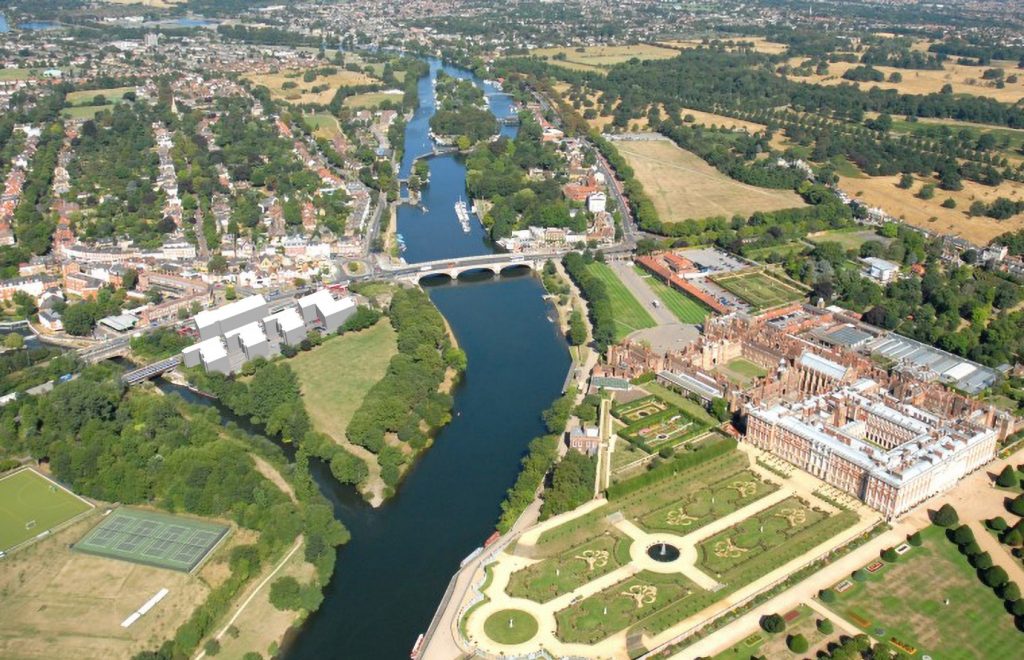The Gardens Trust conservation team have helped to protect the landscape setting of Hampton Court from an overbearing development, after a sustained campaign since 2018. Elmbridge Planning Committee have decisively refused the planning application for the site, which would have engulfed Hampton Court Station in East Molesey, directly opposite Grade I registered Hampton Court.
The station, designed by Sir William Tite in the 1840s, acts as the herald of the Palace for rail visitors. It was sensitively designed in a Jacobean style to complement the Palace and was intended to offer visitors views of the Palace as well as being a feature of the Palace setting and views. This is an excellent result which protects the Palace, its gardens, and other related heritage assets in the conservation area from a dominant development of 97 residential units, a hotel, retail and associated services.

The Gardens Trust had strongly objected to proposals submitted in 2008 and 2018/19 and raised additional concerns with the Council after reviewing the case early this year. No adequate rigorous historic impact assessment had been submitted as part of the planning application, nor were night-time visualisations provided. We reiterated our strong objection to the planning application.
Damage to Hampton Court setting
In February historic environment consultant Dr Sarah Rutherford prepared a historic impact assessment (HIA) pro bono, to which we gave our full support. The assessment set out in detail the impact of the proposed development on each of the heritage assets that would be affected. It concluded that the development would result in substantial harm to the setting of 12 significant heritage assets, including Hampton Court Palace, its garden, park and the Thames landscape, as well as causing some harm to a further 10 assets. It also pointed out that the building would exceed the 50ft limit imposed by the 1913 South Western Railways Act, and would be visible through the trees, as well as greatly increasing light emissions, when seen from Hampton Court Palace.

Site visits demonstrate impact
Although there was an active Hampton Court Rescue Campaign locally and many heritage bodies had registered objections, we were concerned that Historic England had noted that the plans would cause only ‘some harm’ which could be mitigated by tree planting. With the benefit of Dr Rutherford’s HIA, the Gardens Trust therefore began a lobbying campaign in April and Historic Royal Palaces (HRP) joined us in robustly objecting to the development.

Together with HRP we led site visits for the Elmbridge planning councillors around the palace and grounds and worked hard to ensure that they fully understood the detail of the Historic Impact Assessment and the true impact on the setting when viewed from the Palace and its grounds, and from Hampton Court station towards the Palace.
Planning Committee refuses development
The local authority’s report for the planning committee recommended refusal and referenced both our initial objections, additional points and the details of the historic impact assessment. At the planning meeting none of the councillors spoke in favour of the development (there were two abstentions, as the Chair always abstains and one member had a conflict of interest).
Sarah Dickinson, Chair of the Conservation Committee of the Gardens Trust, said: ‘The Gardens Trust, the leading source of expertise on the value and significance of historic designed landscapes, is delighted to have worked successfully with our heritage partners to protect the exceptional historic landscape of Hampton Court Palace, its gardens and unique Arcadian setting. We engaged with those asked to determine the future of this place, sharing our knowledge and passion to help conserve and protect this heritage for the benefit and appreciation of current and future generations.’
The Gardens Trust is most grateful to Dr Sarah Rutherford for her work and to all those campaigners who helped to keep the case in the public eye.


